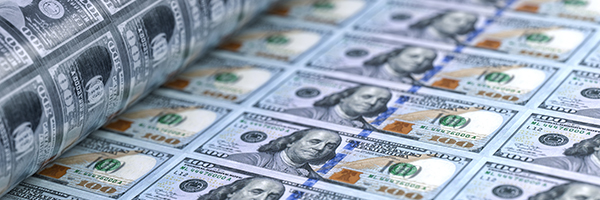
July 26, 2024 | Daily JAM, Morning Briefing |
The Personal Consumption Expenditures index, the Federal Reserve’s preferred measure of inflation, rose by just 0.% month-over-month in June, the Bureau of Economic Analysis reported this morning. The core personal consumption expenditures price index, which strips out volatile food and energy prices, increased 0.2% from May. The annual rate of core inflation was just 2.6%. Economists had projected a core annual rate of 2.5%. With the Fed set to meet on interest rates on July 31, inflation continues to move lower towards the central bank’s 2% target. These numbers support the Wall Street consensus calling for the Fed to begin cutting interest rates at its September 18 meeting.

July 18, 2024 | Daily JAM, Morning Briefing |
With the first Federal Reserve interest rate cut likely at the central bank’s September 18 meeting, some current economic data raise the possibility that the economy is slowing more than the Fed–and Wall Street–would desire.

July 12, 2024 | Daily JAM, Morning Briefing |
The all-items Consumer Price Index (CPI) declined 0.1% In June from May on a seasonally adjusted basis, the Bureau of Labor Statistics reported this morning. The month-to-month CPI inflation rate was unchanged in May.
Over the last 12 months, the all items index increased 3.0% before seasonal adjustment. Economists surveyed by Bloomberg had projected a 3.1% rate. The all-items index rose at a 3.3% annual rate in May. The core index rose at a 3.3% annual rate in June. That was the smallest 12-month increase in that index since April 2021.

July 5, 2024 | Daily JAM, Morning Briefing, Short Term |
The U.S. economy added 206,000 jobs in June, the Bureau of Labor Statistics reported today, July 5. That was above the median forecast of 190,000 new jobs in a Bloomberg survey of economists. But even though the June number came in above expectations, the overall message in the data was that the labor market is slowing. The Bureau of Labor Statistics revised job growth in the prior two months down by 111,000. Average monthly job growth over the last three months slowed to the lowest rate since the start of 2021. And the unemployment rate rose to 4.1%

July 1, 2024 | Daily JAM, Short Term |
There won’t be any stock market reaction to the June jobs report due on Friday That’s because the market closes early on July 3 and stays closed for Friday’s Fourth of July holiday. And not because the report isn’t important as the Federal Reserve continues its search for evidence that the labor market is cooling enough to send inflammation down to the bank’s 2% target. The June report is expected to show that the economy added 188,000 jobs in June.

July 1, 2024 | Daily JAM, Morning Briefing, Short Term |
Wall Street strategists at influential investment giants are starting to recommend buying inflation hedges for 2025.
That means, at the moment, buying at the short-term end of the Treasury market–like 3-month to 12-month bills–and selling at the long-end–like 10-year notes.

June 12, 2024 | Daily JAM, Long Term |
To no one’s surprise, the Federal Reserve left its benchmark interest rate unchanged today, June 12, at a two-decade-high of 5.25% to 5.5%. But that doesn’t mean there wasn’t drama as a result of todays decision.

June 4, 2024 | Daily JAM, Morning Briefing |
Be careful what you wish for. Financial markets have been hoping to see signs of a slowing U.S. economy that would let the Federal Reserve begin to cut interest rates. But after the Institute for Supply Management’s (ISM) manufacturing gauge fell 0.5 point to 48.7 in May, the weakest in three months, in data released on Monday, investors have begun to worry if this much of a slowdown is a good thing.

May 31, 2024 | Daily JAM, Morning Briefing |
The Federal Reserve’s preferred measure of U.S. inflation–the core personal consumption expenditures (PCE) price index, which strips out volatile food and energy prices–rose 0.2% in April from March.That was the smallest advance in 2024, according to Bureau of Economic Analysis data out Friday. And there was more evidence of a slowing economy today.

May 26, 2024 | Daily JAM, Short Term |
I expect Wall Street’s last rate cut bulls to get gradually less bullish. With means, expect to see interest rates (and Treasury yields) continue to rise, and the consensus on when the first cut in rates from the Federal Reserve to continue to move later in 2024. This past week economists at Goldman Sachs threw in the towel on their projections for a July interest rate cut by the Federal Reserve. The investment company moved its forecast for an initial cut to September.“Earlier this week, we noted that comments from Fed officials suggested that a July cut would likely require not just better inflation numbers but also meaningful signs of softness in the activity or labor market data,” the economists wrote in a note.Goldman Sachs had been one of the last banks on Wall Street betting the Fed would start lowering interest rates in July. JPMorgan Chase and Citigroup are among the few holdouts still forecasting a July move. Goldman is still predicting two interest rate cuts in 2024. The swaps market now fully prices in a December cut. The odds of a second reduction in 2024 stand at less than 30%, compared with about 70% last week. At the end of 2023, the first Fed cut was expected as early as March.

May 19, 2024 | Daily JAM |
Today’s video is The Uncertainty of Uncertainty in the Stock Market. Right now we’re seeing uncertainty on top of uncertainty. The CPI numbers just came out and April showed a slightly lower annualized inflation rate than March. The market took this as a signal that we’ve moved past inflation stagnation and have resumed the march towards 2%. This is, of course, an uncertainty. Another uncertainty is the what we don’t know about the inner thinking at the Fed. How much of a decline does the Fed really need to see to start cutting rates? Right now, according to the CME Fedwatch tool, there is a 70% chance that we’ll see interest rate cuts at the September Fed meeting. This prediction has shifted a lot in the last few months and could continue to shift. These uncertainties mean that the market may be fully priced at 5,200. Some analysts suggest we could hit 5,600 by the end of the year, making it a 15-20% year. In the short term, it’s really hard to predict how people react to all these layers of uncertainty. It’s also difficult to hedge this market so I recommend looking at individual stocks in lithium or copper that will continue to go up, even if the market as a whole doesn’t move.

May 10, 2024 | Daily JAM, Videos |
Today’s video is How big a danger is consumer debt? The Federal Reserve has been slowly trying to get inflation down one more percentage point by slowing the economy (without crashing it). One of the things the Fed looks at is how consumers are doing. Consumer revenue is about 70% of the overall economy and consewuently the Fed has been keeping an eye on consumer debt. At the moment, debt as we can measure it, is at a high level with credit card delinquencies at 3.5% in December 2023, the highest since the current data series istarted in 2012. But that number doesn’t capture everything gong on with consumer debt since the increasingly popular Buy Now, Pay Later products aren’t included in the big consumer debt measurements. Thes products let people stretch or delay payments by cutting them into installlments. The Buy now/pay later market is currently only about $18 billion but is projected to hit $700 billion by 2029. What’s th deliquency ratw for Buy now/pay later? No one knows because the companies providing Buy Now, Pay Later programs don’t report delinquencies to credit bureaus. Anecdotally, the delinquwncy rate seems high. A Bloomberg survey found that about 43% of people in Buy Now, Pay Later programs say they’re behind or feeling pressure on their payments. 28% say they’re delinquent on other debt as a result of these payments. Th Fed faces a tough enough job of sailing the economy to a safe harbor without having to steer blind n a big and growing part of the markrt for consumer debt. My worry is that the economy may be slowing faster than the Fed would hope or can accurately measure. Keep an eye on this as the Fed continues to push rate cuts further and further down the road.











